Competitive inhibition - Study guides, Class notes & Summaries
Looking for the best study guides, study notes and summaries about Competitive inhibition? On this page you'll find 1042 study documents about Competitive inhibition.
All 1.042 results
Sort by
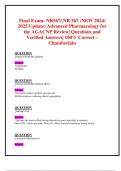 Popular
Popular
-
Final Exam: NR567/ NR 567 (NEW 2024/ 2025 Update) Advanced Pharmacology for the AGACNP Review| Questions and Verified Answers| 100% Correct – Chamberlain
- Exam (elaborations) • 57 pages • 2024
-
Available in package deal
-
- $11.99
- 4x sold
- + learn more
Final Exam: NR567/ NR 567 (NEW 2024/ 2025 Update) Advanced Pharmacology for the AGACNP Review| Questions and Verified Answers| 100% Correct – Chamberlain QUESTION Platelet GB IIb/IIIa inhibitor Eptifibatide Tirofiban QUESTION Chamberlain Platelet GB IIb/IIIa inhibitor MOA Answer: Reversibly binds to platelet glycoprotein IIb/IIIa receptors, reducing platelet aggregation QUESTION Starling's Law Answer: The more the heart is filled during diastole the ...
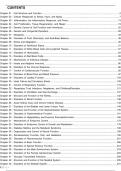 Popular
Popular
-
TEST BANK ESSENTIALS OF PATHOPHYSIOLOGY (4TH EDITION BY PORTH)
- Exam (elaborations) • 263 pages • 2024 Popular
-
- $15.49
- 2x sold
- + learn more
TEST BANK ESSENTIALS OF PATHOPHYSIOLOGY (4TH EDITION BY PORTH) CONTENTS Chapter 01 - Cell Structure and Function .......................................................................................................................... 2 Chapter 02 - Cellular Responses to Stress, Injury, and Aging .......................................................................................... 7 Chapter 03 - Inflammation, the Inflammatory Response, and Fever ..............................................
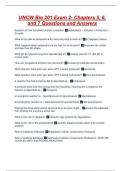
-
UNCW Bio 201 Exam 2- Chapters 5, 6, and 7 Questions and Answers
- Exam (elaborations) • 3 pages • 2024
-
Available in package deal
-
- $8.49
- 1x sold
- + learn more
Equation of how Enzymes function in reaction Substrate(s) + Enzyme = Product(s) + Enzyme What is the optimal temperature for most enzymes to work at? 37 degrees Celsius What happens when temperature is too high for an enzyme? Enzymes can unfold and lose their 3D shape. What pH do cytosolic enzymes operate best at? neutral, around 7.2. (the pH of human cells) How can competitive inhibition be overcome? increasing substrate concentration What direction does actin spin when ATP is being produc...
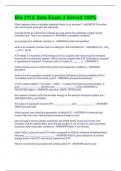
-
Bio 311C Sata Exam 3 Solved 100%
- Exam (elaborations) • 20 pages • 2023
- Available in package deal
-
- $12.49
- 1x sold
- + learn more
What happens when a suitable substrate binds to an enzyme? - ANSWER-The active site amino acids bond with the substrate Cyanide binds to cytochrome oxidase at a site where the substrate oxygen would normally bind. This is an example of - ANSWER-competitive inhibition an example of a catabolic reaction is - ANSWER-lactate fermentation what is an anabolic process that is endergonic and endothermic? - ANSWER-CH₄ +2O₂ → CO₂ + 2H₂O ATP yields 7.3 kcal/mol of free energy and it i...
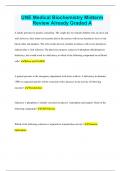
-
UNE Medical Biochemistry Midterm Review Already Graded A
- Exam (elaborations) • 18 pages • 2023
- Available in package deal
-
- $9.99
- 2x sold
- + learn more
UNE Medical Biochemistry Midterm Review Already Graded A A family presents for genetic counseling. The couple has two female children who are alive and well; however, their infant son recently died in the nursery with severe hemolysis (lysis of red blood cells) and jaundice. The wife recalls she lost a brother in infancy with severe hemolysis, induced after a viral infection. The physician suspects a glucose-6-phosphate dehydrogenase deficiency, this would result in a deficiency in which of the...
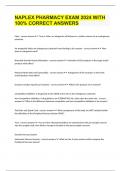
-
NAPLEX PHARMACY EXAM 2024 WITH 100% CORRECT ANSWERS
- Exam (elaborations) • 63 pages • 2024
-
Available in package deal
-
- $16.49
- + learn more
False - correct answer True or False: an antagonist will behave in a similar manner to an endogenous substrate An antagonist blocks an endogenous substrate from binding to its receptor - correct answer How does an antagonist work? Bronchial Smooth Muscle Relaxation - correct answer Activation of B2-receptors in the lungs would produce what effect? Reduced Heart Rate and Contractility - correct answer Antagonism of B1-receptors in the heart would produce what effect? Enzymes catalyze ...
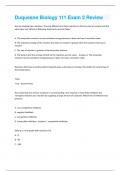
-
Duquesne Biology 111 Exam 2 Review Updated Exam!!
- Exam (elaborations) • 36 pages • 2024
- Available in package deal
-
- $7.99
- + learn more
You are studying two reactions. The only difference in these reactions is that one has an enzyme and the other does not. Which of following statements must be false? A. The enzymatic reaction has less activation energy because it does not have a transition state. B. The activation energy of the reaction that lacks an enzyme is greater than the reaction that has an enzyme. C. The rate of reaction is greater in the enzymatic reaction. D. The delta G and the entropy of both of the reactions a...
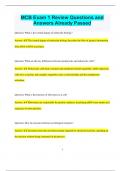
-
MCB Exam 1 Review Questions and Answers Already Passed
- Exam (elaborations) • 19 pages • 2024
-
- $9.99
- + learn more
MCB Exam 1 Review Questions and Answers Already Passed Question: What is the central dogma of molecular biology? Answer: The central dogma of molecular biology describes the flow of genetic information from DNA to RNA to protein. Question: What are the key differences between prokaryotic and eukaryotic cells? Answer: Prokaryotic cells lack a nucleus and membrane-bound organelles, while eukaryotic cells have a nucleus and complex organelles such as mitochondria and the endoplasmic retic...
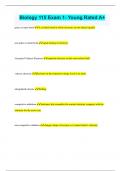
-
Biology 115 Exam 1- Young Rated A+
- Exam (elaborations) • 9 pages • 2024
-
Available in package deal
-
- $9.99
- + learn more
Biology 115 Exam 1- Young Rated A+ polar covalent bond A covalent bond in which electrons are not shared equally non polar covalent bond equal sharing of electrons Un-paired Valence Electrons unpaired electrons on the outer orbital shell valence electrons Electrons on the outermost energy level of an atom unregulated enzyme binding competitive inhibition substance that resembles the normal substrate competes with the substrate for the active site non-competitive inhibitor c...
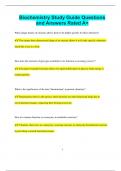
-
Biochemistry Study Guide Questions and Answers Rated A+
- Exam (elaborations) • 12 pages • 2024
-
Available in package deal
-
- $9.99
- + learn more
Biochemistry Study Guide Questions and Answers Rated A+ What unique feature of enzymes allows them to be highly specific for their substrates? The unique three-dimensional shape of an enzyme allows it to fit only specific substrates, much like a key in a lock. How does the structure of glycogen contribute to its function as an energy reserve? Glycogen's branched structure allows for rapid mobilization of glucose when energy is needed quickly. What is the significance of the ...
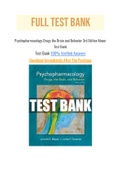
-
Psychopharmacology Drugs the Brain and Behavior 3rd Edition Meyer Test Bank
- Exam (elaborations) • 248 pages • 2022
-
- $24.47
- 10x sold
- + learn more
Psychopharmacology Drugs The Brain And Behavior 3rd Edition Meyer Nursing Test Bank Multiple Choice 1. refer(s) to specific molecular changes that occur when a drug binds to a particular target site or receptor, while are the resulting widespread alterationsin function. a. Drug action; therapeutic effects b. Side effects; drug effects c. Therapeutic effects; side effects d. Drug action; drug effects Answer: d Textbook Reference: Pharmacology: The Science of Drug Action 2. After drug administrati...
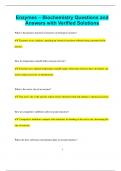
-
Enzymes – Biochemistry Questions and Answers with Verified Solutions
- Exam (elaborations) • 21 pages • 2024
-
Available in package deal
-
- $9.99
- + learn more
Enzymes – Biochemistry Questions and Answers with Verified Solutions What is the primary function of enzymes in biological systems? Enzymes act as catalysts, speeding up chemical reactions without being consumed in the process. How do temperature and pH affect enzyme activity? Enzymes have optimal temperature and pH ranges where they function best; deviations can lead to reduced activity or denaturation. What is the active site of an enzyme? The active site is the specific re...

That summary you just bought made someone very happy. Also get paid weekly? Sell your study resources on Stuvia! Discover all about earning on Stuvia


